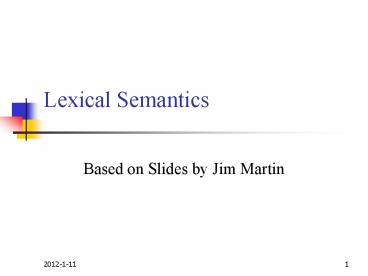Lexical Semantics - PowerPoint PPT Presentation
1 / 26
Title:
Lexical Semantics
Description:
Paradigmatic relations connect lexemes together in particular ways but don't say ... He melted her reserve with a husky-voiced paean to her eyes. ... – PowerPoint PPT presentation
Number of Views:1279
Avg rating:3.0/5.0
Title: Lexical Semantics
1
Lexical Semantics
- Based on Slides by Jim Martin
2
Relations
- Paradigmatic relations
- Synonymy
- Antonymy
- Hyponymy
- Metonymy
3
WordNet
- WordNet is a database of such relations
4
WordNet Relations
5
WordNet Hierarchies
6
Inside Words
- Paradigmatic relations connect lexemes together
in particular ways but dont say anything about
what the meaning representation of a particular
lexeme should consist of. - Thats what I mean by inside word meanings.
7
Inside Words
- Various approaches have been followed to describe
the semantics of lexemes. Well look at only a
few - Thematic roles in predicate-bearing lexemes
- Selection restrictions on thematic roles
- Decompositional semantics of predicates
- Feature-structures for nouns
8
Inside Words
- Thematic roles more on the stuff that goes on
inside verbs. - Thematic roles are semantic generalizations over
the specific roles that occur with specific
verbs. - I.e. Takers, givers, eaters, makers, doers,
killers, all have something in common - -er
- Theyre all the agents of the actions
- We can generalize across other roles as well to
come up with a small finite set of such roles
9
Thematic Roles
10
Thematic Role Examples
11
Examples
- So instead of
- Sally gave Harry a book.
- Giver(Sally)Givee(Harry)Given(book)
- Agent(Sally)Goal(Harry)Theme(book)
- What good does this do us?
12
Thematic Roles
- Takes some of the work away from the verbs.
- Its not the case that every verb is unique and
has to completely specify how all of its
arguments uniquely behave. - Provides a locus for organizing semantic
processing - It permits us to distinguish near surface-level
semantics from deeper semantics
13
Nonce Word examples
- Consider the following example
- He gimbled the frimgly to Mary.
- Who did it?
- What got gimbled?
- Who has the frimgly?
- HeAGENT gimbled the frimglyTHEME to
MaryGOAL
14
Linking
- Thematic roles, syntactic categories and their
positions in larger syntactic structures are all
intertwined in complicated ways. For example - AGENTS are often subjects
- In a VP-gtV NP NP rule, the first NP is often a
GOAL and the second a THEME
15
Inference
- After a verb that expresses a transfer what can
we conclude about the thing labeled THEME with
respect to the thing labeled GOAL?
16
Deeper Semantics
- Honestly from the WSJ
- He melted her reserve with a husky-voiced paean
to her eyes. - If we label the constituents He and her reserve
as the Melter and Melted, then those labels lose
any meaning they might have had. - If we make them Agent and Theme then we dont
have the same problems
17
Problems
- What exactly is a role?
- Whats the right set of roles?
- Are such roles universals?
- Are these roles atomic?
- I.e. Agents
- Animate, Volitional, Direct causers, etc
- Can we automatically label syntactic constituents
with thematic roles?
18
What about Nouns?
19
Selection Restrictions
- Back a few weeks
- I want to eat someplace near campus
- Now we can say that eat is a predicate that has
an AGENT and a THEME - And that the AGENT must be capable of eating and
the THEME must be capable of being eaten
20
As Logical Statements
- For eat
- Eating(e) Agent(e,x) Theme(e,y)Isa(y, Food)
- (adding in all the right quantifiers and lambdas)
21
Back to WordNet
- Use WordNet hyponyms (type) to encode the
selection restrictions
22
Specificity of Restrictions
- Consider the verbs imagine, lift and diagonalize
in the following examples - Imagine a tennis game
- Atlantis lifted Galileo from the pad
- To diagonalize a matrix is to find its
eigenvalues - What can you say about THEME in each with respect
to the verb? - Some will be high up in the WordNet hierarchy,
others not so high
23
Problems
- Unfortunately, verbs are polysemous and language
is creative WSJ examples - ate glass on an empty stomach accompanied only
by water and tea - you cant eat gold for lunch if youre hungry
- get it to try to eat Afghanistan
24
Solutions
- Eat glass
- Not really a problem. It is actually about an
eating event - Eat gold
- Also about eating, and the cant creates a scope
that permits the THEME to not be edible - Eat Afghanistan
- This is harder, its not really about eating at all
25
Discovering the Restrictions
- Instead of hand-coding the restrictions for each
verb, can we discover a verbs restrictions by
using a corpus and WordNet? - Parse sentences and find heads
- Label the thematic roles
- Collect statistics on the co-occurrence of
particular headwords with particular thematic
roles - Use the WordNet hypernym structure to find the
most meaningful level to use as a restriction
26
Motivation
- Find the lowest (most specific) common ancestor
that covers a significant number of the examples































